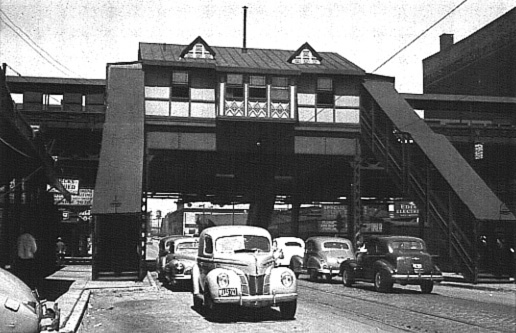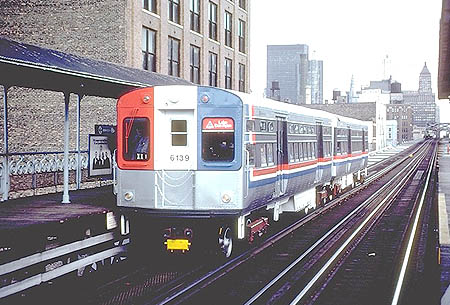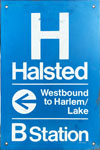|
|
|
|
 The gingerbread Queen Anne styling of the Halsted in this 1946 photo. The station is, however, missing it's characteristic tower. (Photo from the Charles E. Keevil/Chicago Transit Authority Collection) |
|
|
|
|
 The gingerbread Queen Anne styling of the Halsted in this 1946 photo. The station is, however, missing it's characteristic tower. (Photo from the Charles E. Keevil/Chicago Transit Authority Collection) |
Halsted
(800W/200N)
Halsted Street and Lake
Street, Near West Side
Service Notes:
Green Line: Lake
Quick Facts:
Address: 800 W. Lake Street
Established: November 6, 1893
Original Line: Lake Street Elevated Railroad
Previous Names: none
Rebuilt: n/a
Skip-Stop Type:
Station
Status: Demolished
History:
Halsted station was typical of those built in 1892-93 for the Lake Street Elevated Railroad, designed by its engineering staff and built by the Lloyd and Pennington Company.
The station had twin station houses and side platforms for boarding inbound and outbound trains. The station houses were designed in a Queen Anne style with a Victorian Gothic influence. Each was symmetrical (which is unusual for the Queen Anne style), with corrugated metal siding and decorative detail in the metal and wood trim around the windows and in panels below. The front of each station house had a rectangular bay window, with a decorative diamond pattern in panels under the windows. A belt rail divided the exterior horizontally beneath the windows. The station houses had gabled roofs with two windowless gabled dormers each. The typical examples of these station houses on the Lake Street Elevated had a roof topped with a square cupola with a diamond pattern and a steeply hipped roof with a small gabled dormer in each of the four sides. The top of the cupola and the front point of the cupola dormers, roof dormers, and platform canopies were finished with decorative curlicue finials. By the 1940s, Halsted lacked these cupolas (see photo above). It seems unlikely that the Lake Street Elevated would have reproduced all the detail of the others stations, but left off the cupola at Halsted, so it is likely that Halsted's was simply removed some time prior to 1946. These structures represent a unique attempt to apply the Queen Anne architectural style. By the late-1940s, the station was painted in an interesting green multi-tone scheme.
There were originally four stairways from the street up to the station houses: two to each station house, and one on each side of Halsted Street. The stairs led into the station houses, each of which had its own ticket agent and inside waiting room. The unnecessary labor requirements of the track-level station having separate agents for each direction of travel -- a problem shared by the original Loop Elevated stations as well -- was recognized by the railroad company by the early 20th century, but the arrangement of the station houses were never modified by CTA to reduce labor requirements (beyond instituting periods when the stations were unstaffed and fares were collected by conductors onboard the trains).
The side platforms were covered by tin-covered peaked-roof canopies supported by a row of steel center posts. The posts had decorative elements cast into them, most notably in the top angle bracket that supported the canopy braces. The canopies originally covered the full length of the platforms, approximately four railcars long. As the platforms were extended to accommodate longer trains, the canopies only covered the original section of the platform nearest to the station houses. The Lake Street Elevated stations also originally had elaborate railings on the platforms, replaced several times, although Ashland still has some sections of original railing.
The station was closed in 1994 like all the other Lake, Englewood and Jackson Park stations for a two year renovation and rehabilitation, but Halsted never reopened, a casualty of service cuts. It was demolished shortly after the Green Line reopened in 1996. Provisions for a replacement station a few blocks west at Morgan were made during the rehab, but construction of this stop in this gentrifying neighborhood did not begin until over a decade later.
 6139 leads a 2-car westbound Lake-Dan Ryan "A" train at Halsted/Lake on November 11, 1977. Several 6000s, like 6139-6140, received a new red/white/blue paint scheme after the 2400s arrived with it in 1976, a variation of the Bicentennial scheme. Note the original decorative iron railings on the platform. For a larger view, click here. (Collection of Joe Testagrose) |
 |
halsted-lake-P-8_KDRsignWB.jpg (198k) |
|